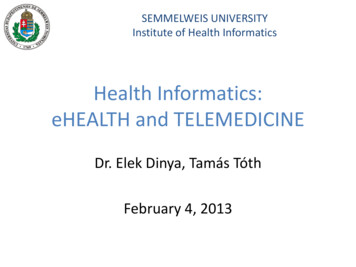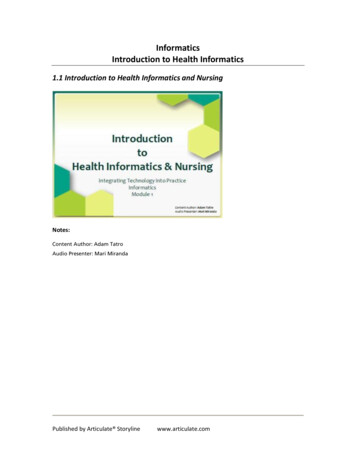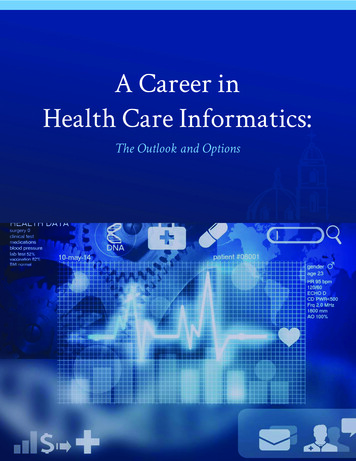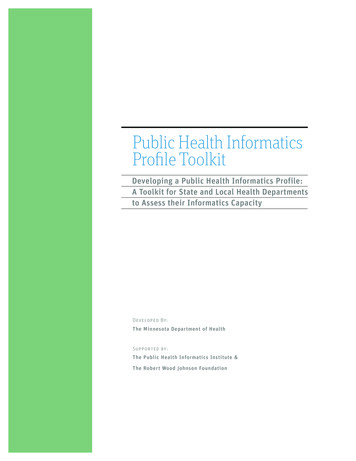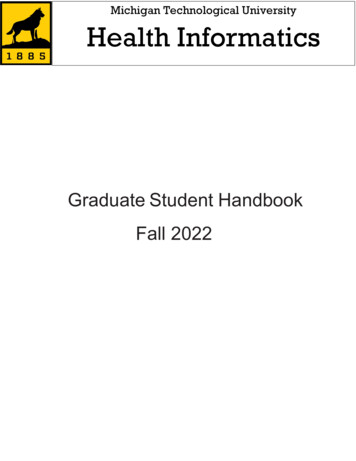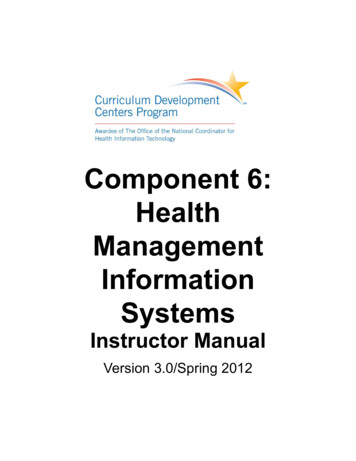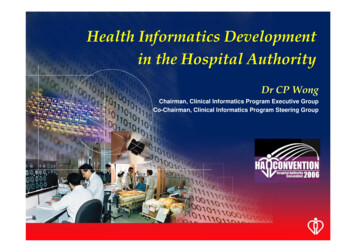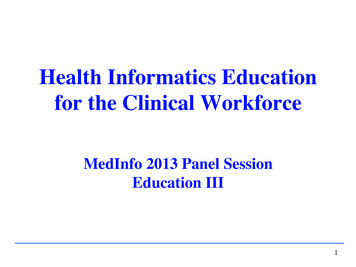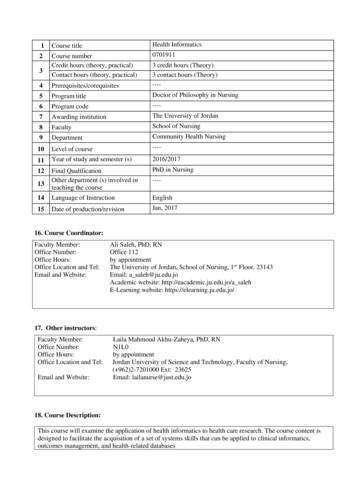
Transcription
1Course titleHealth Informatics2Course numberCredit hours (theory, practical)Contact hours (theory, practical)07019114Prerequisites/corequisites3 credit hours (Theory)3 contact hours (Theory)----5Program titleDoctor of Philosophy in Nursing6Program code----7Awarding institutionThe University of Jordan8FacultySchool of Nursing9DepartmentCommunity Health Nursing10Level of course----11Year of study and semester (s)2016/201712Final QualificationOther department (s) involved inteaching the coursePhD in Nursing14Language of InstructionEnglish15Date of production/revisionJan, 2017313----16. Course Coordinator:Faculty Member:Office Number:Office Hours:Office Location and Tel:Email and Website:Ali Saleh, PhD, RNOffice 112by appointmentThe University of Jordan, School of Nursing, 1st Floor. 23143Email: a saleh@ju.edu.joAcademic website: http://eacademic.ju.edu.jo/a salehE-Learning website: https://elearning.ju.edu.jo/17. Other instructors:Faculty Member:Office Number:Office Hours:Office Location and Tel:Email and Website:Laila Mahmoud Akhu-Zaheya, PhD, RNN1L0by appointmentJordan University of Science and Technology, Faculty of Nursing,( 962)2-7201000 Ext: 23625Email: lailanurse@just.edu.jo18. Course Description:This course will examine the application of health informatics to health care research. The course content isdesigned to facilitate the acquisition of a set of systems skills that can be applied to clinical informatics,outcomes management, and health-related databases
The University of JordanCourse SyllabusAccreditation and Quality Assurance Center19. Course aims and outcomes:A- Aims:This course examines the utilization and application of informatics and information technology in supportingdecision-making in clinical practice, research, education, administration, and healthcare management.Understanding how informatics processes use and apply data, information, and knowledge in healthcare, helpsthe clinician effectively utilize technology to plan, implement, and achieve optimal health outcomes.B- Intended Learning Outcomes (ILOs): Upon successful completion of this course students will be able to 1.2.3.4.5.Understand the influence and impact of informatics on practiceApply informatics technology in selected settingsEvaluate the effectiveness of informatics technology in selected settingsFormulate informatics research needs and opportunitiesPlan care and document health outcomes using informatics6. Recognize the impact of ethical standards in the utilization of technology and informatics in healthcare20. Topic Outline and Schedule:TopicWeekIntroduction tocourserequirementsand materialsHealth/ nursinginformaticsInstructorWeek 129/1-2/2Dr. Ali SalehDr. LailaAkhu-ZaheyaWeek 25/2-9/2Dr. LailaAkhu-ZaheyaAchievedILOsILO 1EvaluationMethods Presentation ParticipationReferenceCh. 1 (Saba &McCormick) d supportinghealth careenvironmentWeek 312/2-16/2Application ofHealth/NursingInformatics:LeadershipWeek 419/2-23/2Application ofHealth/NursingInformatics:ResearchWeek 526/2-2/31Dr. LailaAkhu-ZaheyaILO 1 Presentation ParticipationCh. 2 (Hannah et.al.)Ch. 15 & 16 (Saba &McCormick) CritiqueofInformaticsStudyDr. Ali SalehILO 2 Presentation ParticipationCh. 1 & 2 (Englebardt& Nelson)Ch. 17-19, 21 (Saba& McCormick) CritiqueDr. LailaAkhu-ZaheyaILO 4ofInformaticsStudy Presentation Participation Critique ofInformaticsStudyCh. 10 (Hannah et.al.)Ch. 47 & 48 (Saba &McCormick)Ch. 13 & 19 (Hannahet.al.)
The University of JordanApplication ofHealth/NursingInformatics:EducationWeek 65/3-9/3NursingInformatics inPractice Part 1Week 712/3-16/3Course SyllabusDr. LailaAkhu-ZaheyaILO 2Accreditation and Quality Assurance Center Presentation ParticipationCh. 42-46 (Saba &McCormick) CritiqueofInformaticsStudyDr. Ali SalehILO 2ILO 5 Presentation ParticipationCh. 20 & 21 (Hannahet.al.)Ch. 26-28, 30 (Saba& McCormick) CritiqueofInformaticsStudyNursingInformatics inPractice Part IIWeek 819/3-23/3Hakeem (GuestSpeaker)TelehealthWeek 926/3-30/3Week 102/4-6/4Dr. Ali SalehILO 2 Presentation ParticipationCh. 8 (Hannah et.al.)Ch. 29, 25, 32, & 33(Saba & McCormick) CritiqueofInformaticsStudyILO 2Dr. Ali SalehILO 2 Presentation ParticipationCh. 22 (Saba &McCormick) CritiqueofInformaticsStudyEthics andhealthinformaticsStandardizationWeek 119/4-13/4Dr. LailaAkhu-ZaheyaILO 6 Presentation ParticipationandAssignment Critique ofInformaticsStudyWeek 1216/4-20/4Dr. Ali SalehILO 3 Presentation ParticipationCh. 3 & 9 (Hannahet.al.)Ch. 10 (Saba &McCormick)Ch. 2 (Hannah et.al.)Ch. 7, 8, & 38 (Saba& McCormick) CritiqueofInformaticsStudyPresentationsWeek 1323/4-27/4Ch. 7 (Hannah et.al.) Presentation Participation ProjectPresentationsWeek 1430/4-4/5 Presentation Participation Project21. Teaching Methods and Assignments:Development of ILOs is promoted through the following teaching and learning methods: Interactive lectures Group discussions Seminars and presentations Individual projects E-learning using Moodle2
The University of JordanCourse SyllabusAccreditation and Quality Assurance Center22. Evaluation Methods and Course Requirements:Opportunities to demonstrate achievement of the ILOs are provided through the following assessment methodsand requirements:1. Participation and Assignments2. Presentation3. Critique of Informatics Study4. Project20%15%25%40%Discussion/Participation (20%)Discussion builds an academic community and is an integral component of this class as various readings will beaddressed with their implications to informatics practice and specific disciplines. In addition, the text readingswill serve as an introduction to the class topic content.All are expected to contribute to the class discussion. Discussion involves course content being exploredthrough dialogue of the presented topic. While the participants express their synthesis of the readings thatgenerate the discussion topic, participation is expected to be meaningful, not only expressing one’s opinion.Discussion questions serve to initiate and guide the discussion, but not merely limit it only to what is posed.Discussion is expected to contribute new ideas, introduce related topics, broaden or focus the discussion, orextend/develop the discussion in some way. Therefore, contributions to the discussion reflect thought,preparation, and intellectual discovery. Responses that consist of “I agree,” or “That’s what I was thinking,” areweak responses and are not reflective of appropriate discussion. Responses that consist of moving the topicforward through challenging the posts (with appropriate rationales), or providing an alternative explanation orsynthesis (with appropriate rationales) are examples of stronger responses to the discussion.In a learning community, the primary goal is to build that community through discussion and participation,where academic imagination flourishes. As a participant in this process, all are expected to treat one anotherwith respect and adhere to standards of academic integrity, honesty and fairness.This includes: Being prepared for active participation in the discussion. Respecting the diversity of others’ experiences and perspectives, even if it differs from yours. Dissent canbe done respectfully. Taking credit only for your work and giving credit to other sources from which you draw your ideas.Presentation (15%)Each class member will do a presentation on a selected informatics topic. Approval of assigned faculty memberregarding the outline of the presentation is required at least one week before the presentation date. Thepresentation should consist of a powerpoint presentation. Grading will be done using a rubric that addresses thequality of the presentation content and presenter skills.Informatics Study Critique (25%)What informatics research has been done to address the utility and application of informatics into practice?Select a database informatics article describing an informatics research study.Critique the article (research article) using these guidelines: Does the title tell you about the research with major informatics ideas included? If a discipline specificarticle, did the title indicate it?Is the study reason clearly identified with significance for informatics?Can the study problem be answered with empirical evidence from health informatics practice?Is the specific research purpose stated and how it relates to informatics?Evaluate the methodologies used: type of study, design, variables, sampling, data analysisDo the results support or reject the study question?3
The University of Jordan Course SyllabusAccreditation and Quality Assurance CenterWhat knowledge for informatics is confirmed or generated by the study and does it relate to existingtheory or informatics knowledge?Submit the critique both in class as well as via email. The critique should be done in APA format.Application Project (40%)Consider that you are a Healthcare Informatics Specialist. You have been asked to evaluate the current internalworkflow and make a recommendation regarding the workflow, communications, protocol and architecturerequired in order to select a new healthcare information system for any setting based on your experience. Theproject will be a paper (approximately 10-15 pages and should be done in APA format) and presentation thatwill be suitable for presenting to senior management. In addition, you will prepare a 15-minute Slidepresentation that presents your findings and includes the following:1) Situation Analysis. Describe the "real" or hypothetical work environment, provider objectives and currentinformation systems configuration, as well as any unmet needs or issues. Indicate pros, cons and unresolvedissues for the current system.2) Workflow Requirements. List or otherwise characterize the key workflows, protocols, communications,etc., requirements to be met by the new or upgraded health information system.3) System Selection and Implementation. Describe the steps required for new system selection andimplementation.4) System Evaluation, Support, and Maintenance. Propose a plan to evaluate, support, and maintain theimplemented system.23. Course Policies:Course ExpectationsAs doctoral students, the expectation is that the learner seeks out the information and learning opportunitiesbeyond the basic readings and requirements listed for each class meeting. The doctoral student is the futureleader in nursing. As such, the learner must expand and develop their knowledge base to meet the requirementsof leader, researcher, educator and advocate for the population they will serve.The faculty member facilitates learning on the doctoral level. The learner must then organize informationgathered from the readings, professional background, and previous education to synthesize and integrate theseto apply this knowledge in the class. Learning is done through interaction with others in the class and applyingthe information previously gathered. All come to this class with different levels of knowledge, expertise, andskills to share, thereby creating a diversity of input. Everyone thus benefits from what we all have to offer.It is the hallmark of professional nursing and doctoral education that ethical behavior in academic honesty isdemonstrated in all work that is submitted. References are to be scholarly and follow the APA rule for notexceeding 5 years in date (unless a classic source or previously approved by the faculty member). Plagiarism oracademic honesty will result in consequences, which could include dismissal from the course or the receipt of afailing grade.Communication with faculty may be accomplished through email (preferred) or by phone. Please make emailyour first mode of contact for routine questions. While the faculty will make every attempt to get back to you ina timely manner, please allow 24 to 48 hours for me to reply back to your questions. Please don’t hesitate tocontact faculty if you have questions about the course or assignments.A- Attendance policies: Students must attend all classes of this course. Any student with absence of 15% of the classes of any course, will be illegible to sit for the final exam4
The University of JordanCourse SyllabusAccreditation and Quality Assurance Centerand will be given the university zero (F grade) in this course. In the case (b) above, if a student submits an official sick report authenticated by university clinic or anaccepted excuse by the Dean of his/her faculty, the student will be considered as withdrawn from thecourse, and a "W" will be shown in the transcript for this course. Students are not allowed to come late to classes. Any student coming late will not be allowed to attendthe class and he/she will be marked absent.B- Absences from exams and handing in assignments on time: Assignments and projects should be submitted to the instructor on the due date.C- Honesty policy regarding cheating, plagiarism, misbehavior:Cheating, plagiarism, misbehavior are attempts to gain marks dishonestly and includes; but not limited to: Copying from another student’s work.Using materials not authorized by the institute.Plagiarism which means presenting another person’s work or ideas as one’s own, without attribution.D- Grading policy:A grade of (C ) is the minimum passing grade for the course.F- Available university services that support achievement in the course: Faculty members website E-Learning website24. Required equipment: Audio-Visual Aids Faculty member’s Website E-Learning Website25. References:A- Required book (s), assigned reading and audio-visuals: Hannah, K., Hussey, P., Kennedy, M., Ball, M. (2015). Introduction to Nursing Informatics 4 th ed.Springer: USA Saba, V.; McCormick, K. (2015) Essentials of Nursing Informatics. 6th ed. McGraw-Hill Education:USAB- Recommended books, materials, and media: American Psychological Association. (2009). Publication Manual of the American PsychologicalAssociation. (6th ed.). Washington, DC: American Psychological Association.Anderson, J. and Aydin , C. (2005). Evaluating the Organizational Impact of Healthcare InformationSystem. Springer: USA5
The University of Jordan Course SyllabusAccreditation and Quality Assurance CenterBerner, E. (2007). Clinical Decision Support System :Theory and Practice. Springer: USAEnglebardt, S. & Nelson, R. (2002). Health Care Informatics: An Interdisciplinary Approach.Philadelphia, PA: MosbyKumar, S. , Snooks, H. (2011). Telenursing. Springer: LondonOfei-Dodoo, S., Medvene, L., Nilsen, K.M., Smith, R.A., & DiLollo, A. (2015). Exploring thePotential of Computers to Enrich Home and Community-Based Services Clients' Social Networks.Educational Gerontology, 41(3), 216-225.Cella, A.,& Rebelo, D., (2015). Sustaining the Human Experience in a High Tech Environment: EMRImplementation. Medsurg Nursing: Official Journal of The Academy of Medical-Surgical Nurses, 24(2), 8-9.26. Additional information:Name of Course Coordinator: -------------------Signature: ------------------------- Date: ------------------------- Headof curriculum committee/Department: ------------------------- Signature: --------------------------------Head of Department: ------------------------- Signature: --------------------------------Head of curriculum committee/Faculty: ------------------------- Signature: --------------------------------Dean: ------------------------------------------- -Signature: ---------------------------------Copy to:Head of DepartmentAssistant Dean for Quality AssuranceCourse File6
3. Evaluate the effectiveness of informatics technology in selected settings 4. Formulate informatics research needs and opportunities 5. Plan care and document health outcomes using informatics 6. Recognize the impact of ethical standards in the utilization of technology and informatics in healthcare 20. Topic Outline and Schedule:
